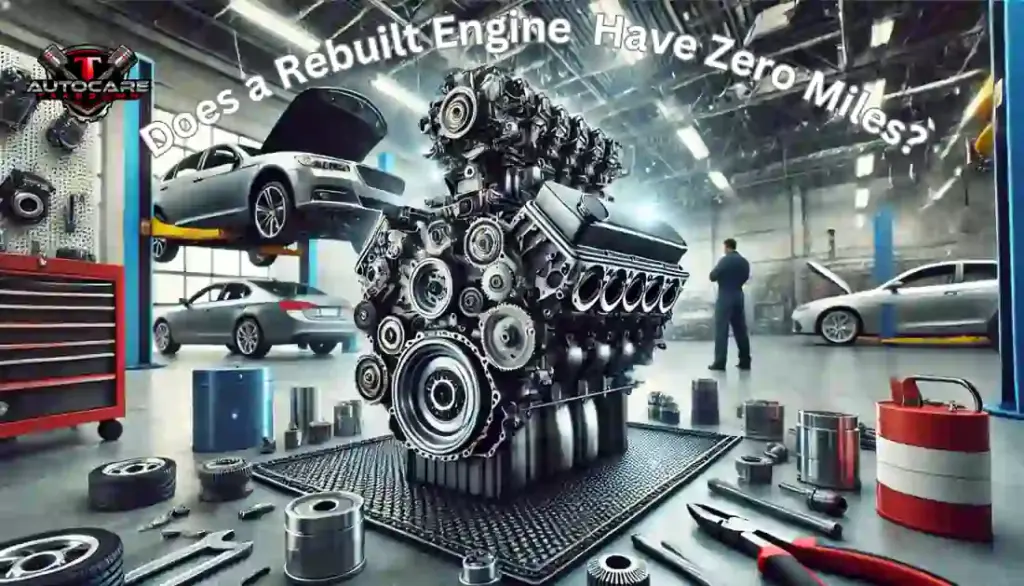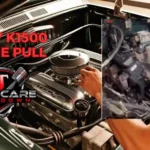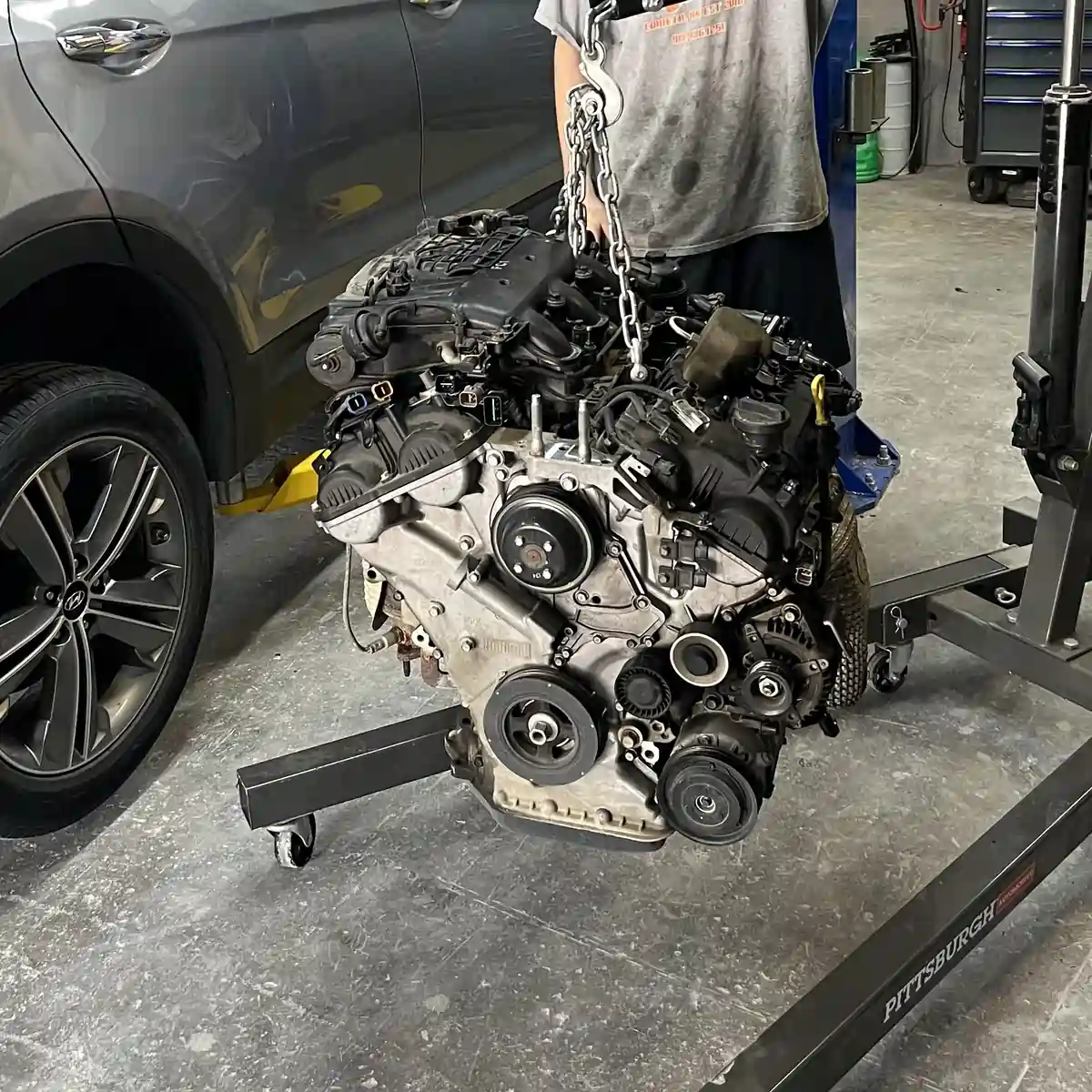A rebuilt engine doesn’t have 0 miles. While it may have been overhauled and improved, it retains its original mileage. But how does a rebuilt engine impact the performance and longevity of your vehicle? Let’s explore.
Does a rebuilt engine start with 0 miles? How does it compare to an engine swap?
This article answers common questions about rebuilt engines and how they impact mileage.
Live in Broken Arrow? T Autocare Takedown provides expert advice and trustworthy Broken Arrow auto repair services to help with all your engine concerns.

Understanding Rebuilt Engines
What is a Rebuilt Engine?
A rebuilt engine is one that has been taken apart, cleaned, inspected, and had worn-out parts replaced or refurbished. Learn more about the importance of regular maintenance to keep your rebuilt engine in top condition.
The goal is to restore the engine to a reliable working condition.
Rebuilt engines are different from remanufactured and used engines in several ways:
Rebuilt engines combine both new and reused parts to restore the engine to reliable working condition. During the rebuild process, any worn or damaged components are replaced or refurbished, ensuring the engine is capable of performing well, though it may not be fully equivalent to a new engine.
To learn more about the importance of maintaining your engine, check out our guide on how to tell if your fuel injectors are bad.
Remanufactured engines, on the other hand, are restored to their original factory specifications. This process often involves the use of entirely new parts, making remanufactured engines closer in performance and longevity to a brand-new engine straight from the factory.
Lastly, used engines are simply taken from another vehicle without undergoing any modifications or refurbishments. While this option may be the most cost-effective, it carries more risk, as these engines are sold in the condition they were in when removed from their previous vehicle.
The Process of Rebuilding an Engine
Rebuilding an engine involves several critical steps to ensure the engine is restored to a reliable state:
Disassembly: The first step in rebuilding an engine is disassembling it. The entire engine is taken apart, allowing each component to be carefully examined. This process ensures that no part is overlooked, providing a clear understanding of the engine’s overall condition.
Cleaning: After disassembly, all parts are thoroughly cleaned. This step is crucial for removing grime, carbon deposits, and any build-up that may have accumulated over time. A clean engine allows for more accurate inspections and helps ensure that reassembled components function properly.
Inspection: Once cleaned, each part is meticulously inspected for signs of wear, damage, or potential failure. Critical components such as the crankshaft, camshaft, and connecting rods are evaluated to determine whether they can be reused or need replacement. The goal is to identify any weaknesses that could affect engine performance.
Replacement and Refurbishment: Any parts that are found to be worn out or damaged during inspection, such as pistons, bearings, and gaskets, are either replaced with new components or refurbished to meet proper standards. This ensures that the engine will operate reliably once reassembled.
Reconditioning: In this stage, components like the engine block, cylinder heads, and other structural elements are reconditioned to ensure they meet precise specifications. This may involve resurfacing, honing, or machining to restore proper fit and function, ensuring the engine runs smoothly.
Reassembly: Finally, the engine is reassembled using a combination of new and refurbished parts. This step is performed with great attention to detail to ensure all components are properly fitted and torqued to the manufacturer’s specifications. The engine is then ready for testing to confirm its reliability and performance.

Mileage on a Rebuilt Engine
Concept of Mileage
Mileage is the total distance a vehicle has traveled, shown on the odometer.
Rebuilding an engine doesn’t reset the odometer to 0 miles.
Instead, the vehicle’s mileage stays the same, showing how far the car has traveled over its lifetime.
Initial Mileage Consideration
Although a rebuilt engine might be seen as having “0 miles” on the rebuild, this is different from the odometer reading. The odometer will still show the vehicle’s total mileage.
So, a rebuilt engine doesn’t truly start with 0 miles in the usual sense.
Factors Influencing Mileage Perception
Several factors influence how the mileage of a rebuilt engine is perceived, including the quality of parts, driving conditions, and regular maintenance. Understanding different types of fuel additives can also play a role in maintaining engine performance and fuel efficiency.
Quality of the Rebuild:
The quality of a rebuilt engine largely depends on the parts used and the skill of the technicians performing the rebuild. High-quality rebuilds typically use Original Equipment Manufacturer (OEM) parts, which are specifically designed for the engine. Skilled labor ensures that these parts are installed correctly and that the rebuild follows precise specifications. A well-executed rebuild with OEM parts can significantly extend the engine’s lifespan, often matching or exceeding the durability of a new engine.
Parts Replaced:
The extent of part replacement or refurbishment directly affects the engine’s performance and longevity. Critical components such as pistons, bearings, and gaskets often need to be replaced to restore the engine’s reliability. However, understanding the role of more intricate parts, like car sensors and their functions, can also be crucial. Sensors help monitor and adjust various engine parameters, and replacing faulty or outdated sensors can improve efficiency and prolong the engine’s life by ensuring optimal operation. If you’re experiencing issues, consider scheduling a car sensor repair to keep your engine running smoothly.
Maintenance and Driving Conditions: After the rebuild, the longevity of the engine also depends on regular maintenance and how the vehicle is driven. Consistent oil changes, timely repairs, and following manufacturer-recommended service intervals are essential to maintaining the health of a rebuilt engine. Additionally, driving conditions play a significant role. Harsh driving environments, such as extreme weather or stop-and-go traffic, can accelerate wear on the engine. Adopting safe driving practices, such as following safe driving tips in rainy conditions, can help reduce strain on the engine and improve its overall durability.
Legal and Practical Considerations
Legal Aspects
When selling a car with a rebuilt engine, being honest and having the right paperwork is important.
Let the buyer know about the engine rebuild and give them details of the work done.
This helps follow legal rules and builds trust.
Impact on Resale Value
The impact of a rebuilt engine on resale value varies. When considering resale, understanding automotive insurance coverage for engine parts is important to ensure you’re fully covered.
Positive Impact:
A well-executed engine rebuild, especially one performed by a reputable mechanic or a certified shop, can positively influence the resale value of a vehicle. When the rebuild is properly documented, including detailed records of the parts replaced and the work completed, it instills confidence in potential buyers. Buyers value transparency and knowing that the engine has been restored with high-quality components and expert care. This can make the vehicle more attractive in the used car market, especially when the rebuild is backed by warranties or certifications that further demonstrate its reliability. Additionally, a rebuilt engine can extend the overall lifespan of the vehicle, which buyers often see as a strong selling point, particularly if the rebuild addresses common engine issues.
Negative Impact:
On the other hand, if the rebuild is poorly documented or completed by an unreliable source, it can have the opposite effect. Buyers may view a rebuild with skepticism if there is a lack of information about what parts were used, who performed the work, or if substandard materials were involved. A poorly executed rebuild can lead to further mechanical issues down the road, which may discourage buyers who are looking for a dependable vehicle. If the quality of the rebuild is questionable, or if there are concerns about the workmanship, it might reduce the vehicle’s resale value or even deter buyers altogether. Buyers may worry about future breakdowns or costly repairs, making them less inclined to invest in the car.
Warranty and Maintenance
Rebuilt engines typically come with warranties, often ranging from 1 year/12,000 miles to longer terms. Proper maintenance, like regular timing job checks, helps extend the engine’s longevity.
One of the key factors in extending the life of a rebuilt engine is proper maintenance of critical components, such as the timing belt. The importance of timing belt replacement cannot be overstated, as neglecting this essential task can lead to significant engine damage. By ensuring timely replacement, you can help your rebuilt engine perform efficiently and avoid costly repairs down the road.
Standard Warranties:
Many auto repair shops that perform engine rebuilds offer a standard warranty, typically covering 1 year or 12,000 miles, whichever comes first. This type of warranty provides basic protection and peace of mind for vehicle owners, ensuring that if any issues arise with the rebuilt engine within this time frame, the shop will handle repairs or replacements. Standard warranties generally cover the essential components of the rebuilt engine, but it’s important to understand the specific terms and conditions. For instance, coverage may only apply if the engine is properly maintained according to the shop’s or manufacturer’s recommendations. While this is a shorter-term warranty, it demonstrates the shop’s confidence in the quality of their rebuild work and offers a basic safety net for owners.
Extended Warranties:
Some providers go beyond the typical 1-year/12,000-mile warranty and offer extended warranties, which can last up to 36 months or even come with unlimited miles. These extended warranties are particularly valuable for drivers who plan to keep their vehicles for the long term or for those who frequently drive long distances. Extended warranties not only provide longer protection but may also cover more comprehensive aspects of the rebuilt engine. For instance, they might include coverage for additional components or labor costs, and some extended warranties may even be transferable to a new owner if the vehicle is sold during the warranty period, adding extra resale value. Extended warranties often reflect the highest level of confidence from the repair provider in the durability and performance of their rebuilt engines, making them an attractive option for vehicle owners seeking long-term assurance.
Regular maintenance is crucial to ensure the longevity of a rebuilt engine, including oil changes, timely repairs, and understanding the importance of engine tune-ups, which are vital for peak performance. It’s also important to monitor your braking system—learn how to know when your rotors need replacing to ensure your vehicle remains safe on the road.
Maintaining a car, especially after significant repairs like a rebuilt engine, can quickly become expensive. To manage these costs, it’s important to consider a car maintenance budget that helps you save money over time. This way, even though a rebuilt engine might not technically have 0 miles, you can still ensure its longevity by adhering to a regular maintenance schedule and keeping an eye on potential future repairs.
Expert Opinions and Real-World Examples
Expert Insights
Automotive experts generally view rebuilt engines favorably if rebuilt correctly:
Quality and Longevity: Automotive experts, including those from Kelley Blue Book and the Car Talk Community, consistently stress the importance of using high-quality parts and skilled labor when rebuilding an engine. The longevity of a rebuilt engine heavily depends on the quality of the components used and the expertise of the mechanics performing the rebuild. Inferior parts or lackluster workmanship can lead to premature failure or ongoing issues. Ensuring that OEM or high-grade aftermarket parts are used in the rebuild can significantly extend the engine’s life. In addition to the rebuild process, it’s crucial to be aware of common engine issues such as overheating, oil leaks, or timing belt wear, which can develop over time. Taking steps to address these issues early on through proper maintenance can prevent long-term damage, allowing the rebuilt engine to perform at its best for many years.
Comparison to Remanufactured Engines: When comparing rebuilt engines to remanufactured ones, a key difference lies in the restoration process. Remanufactured engines are completely restored to their original factory specifications, often involving a more thorough and precise rebuild. This process typically uses brand-new parts for key components, such as the pistons, crankshaft, and cylinder heads, ensuring that the engine performs as close to a new engine as possible. As a result, remanufactured engines tend to have longer lifespans and are often backed by more comprehensive warranties than rebuilt engines. These warranties may cover up to several years or include unlimited mileage, providing greater peace of mind to vehicle owners. The factory-level precision and the use of exclusively new parts in remanufactured engines make them an appealing choice for those seeking a near-new engine experience, though this often comes with a higher price tag compared to a rebuilt engine.
Case Studies
Real-world examples highlight various outcomes for vehicles with rebuilt engines:
- Positive Outcomes: Vehicles with well-documented rebuilds and high-quality parts often perform well and have satisfied owners.
- Challenges: Cases where the rebuild involved substandard parts or poor workmanship show reduced performance and shorter lifespans.
Related Articles to
Keep Your Rebuilt Engine Running Smoothly
Maintaining a rebuilt engine goes beyond the initial repairs. Regular care and attention to key components can make all the difference in ensuring your engine stays reliable for years to come. Below are some valuable resources that can help you better understand how to maintain and extend the life of your rebuilt engine:
Understanding Oil Leaks: Oil leaks can lead to serious engine problems if not addressed. This article explains how to identify and fix oil leaks, helping you protect your rebuilt engine from unnecessary wear and tear.
Tips for Improving Fuel Efficiency: A rebuilt engine can benefit from improved fuel efficiency. Discover practical tips to help you save on fuel costs while ensuring your engine runs optimally.
How to Perform a Compression Test on Your Engine: A compression test can reveal important details about your rebuilt engine’s health. Learn how to perform this test yourself and detect any potential issues early.
How to Diagnose a Check Engine Light: If the check engine light appears on your rebuilt engine, diagnosing the cause is crucial. This guide walks you through the steps to identify and resolve common issues.
Is It Cheaper to Repair or Replace an Engine?: Deciding between repairing or replacing an engine can be challenging. This article helps you weigh the options, especially when considering the cost-effectiveness of a rebuilt engine.
How to Tell if Your Fuel Injectors are Bad: Faulty fuel injectors can affect your engine’s performance. Learn how to spot the signs of bad injectors and what steps to take to keep your rebuilt engine running efficiently.
Preparing Your Car for Summer Road Trips: Proper preparation is key for long drives, especially with a rebuilt engine. Follow these tips to get your car ready for safe and enjoyable summer road trips.
These articles offer practical tips and essential knowledge that will help you get the most out of your rebuilt engine and keep it running at its best.
Conclusion
Summary of Key Points
Rebuilt engines do not start with 0 miles on the vehicle’s odometer, although they can be considered to have “0 miles” on the rebuild itself.
The overall mileage perception depends on the quality of the rebuild, parts used, and subsequent maintenance.
Final Thoughts
Understanding the distinction between a rebuilt engine and overall vehicle mileage is crucial for making informed decisions about engine repairs and purchases.
Quality rebuilds can significantly extend an engine’s life, provided they are performed by skilled professionals using high-quality parts.
Live In Broken Arrow?
If you’re thinking about buying a car with a rebuilt engine or need an engine rebuild, it’s important to talk to professionals and get detailed records.
We Do Engine Swaps
We have done numerous engine swaps. If you would like to learn How to Choose Between Used Engines, Rebuilt Engines, & Remanufactured Engines, feel free to call our shop.
For expert advice and reliable engine rebuilding, contact T Autocare Takedown at (539) 367-3738.
Additional Resources
These are the sources we used to research and write this blog post.
Below, you’ll find trusted resources that provide helpful information about rebuilt engines and related topics. They can guide you in making informed decisions about your car.
FAQs
Q: Does a rebuilt engine affect the odometer reading?
A: No, the odometer reading remains the same as it reflects the total mileage of the vehicle.
Q: How long does a rebuilt engine last?
A: A well-rebuilt engine can last many years and miles, often similar to a new engine, depending on the quality of the rebuild and maintenance.
References
- Kelley Blue Book: Rebuilt vs. Remanufactured Engines(Kbb.com)
- Car Talk: Buying a Used Car with Rebuilt Engine(Car Talk Community)
- Drivparts.com: Rebuilt vs Remanufactured Engine(DRiV | Quality Auto Parts)
- Motor Guy: Benefits and Costs of Rebuilding an Engine(The Motor Guy)
- Four Wheel Trends: How Many Miles Will a Rebuilt Engine Last?(Four Wheel Trends)
- Cannon Auto Repair: How Many Miles Will a Rebuilt Engine Last?(Cannon Auto Repair)
For more information, visit T Autocare Takedown at 1501 W Detroit St, Broken Arrow, OK 74012, or call (539) 367-3738.











